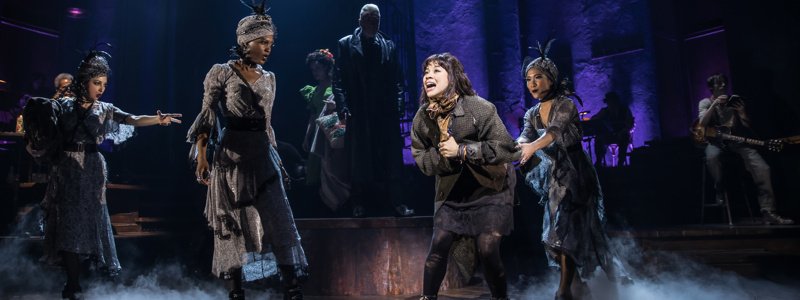The Brilliance and Importance of "Hadestown"
(Photo: Helen Maybanks)
Rose Riley
This past weekend, I had the immense pleasure of visiting the Walter Kerr Theatre with a high school theatre company to see “Hadestown.” Going in, I had seen bits of the promo video, I had heard a few of the songs, and I knew the premise of the plot- Orpheus, and Eurydice set in a bluesy coal mining town kind of style. I knew, basically, what the production looked like, and I knew what it sounded like.
What I did not know, is what it would feel like.
For the next couple of hours, we, the audience, sat there in the dark, eyes and ears wide, as a sensation which I can only describe as wonder was collectively felt, and expressed in between songs, throughout the room. Together, we shivered as Reeve Carney (Orpheus) sent his soaring falsetto from the stage to the far ceiling and back again. Together, we smiled as Amber Gray (Persephone) moved expertly through space and made sure to engage in playful eye contact with every single one of us. Together, we listened intently to the church-bell-like voice of Eva Noblezada (Eurydice) capture every thought and emotion in her character’s head with expert grace and control. Together, our sternums shook as Patrick Page (Hades) bellowed out masterful bass notes which were six-feet-underground deep. We delighted in the wisdom, sass, and charm André De Shields (Mr. Hermes) brought to the narration of the story. We felt every ounce of energy radiated by the exceptional ensemble. We felt the entire show.
So, what does Hadestown feel like?
To honestly answer this question, I would have to bring you to the show so you could see it- feel it- for yourself. But I shall do my best through my laptop.
Simply put, Hadestown feels like art. One of my first comments to a colleague after the show was, literally, “That there was a prime example of theatre as an art form.” And the more I have thought about it, the more I understand precisely why. What the cast and creative team of this piece have done with the creation of Hadestown is this: they have taken the concept of a Broadway show, a piece of theatre, and they have concentrated and expanded upon the core of the artistry of it. They have stripped it down to the “meat and potatoes,” so to speak, and celebrated the most crucial aspects of performing arts- it is a true love letter to the artistry of the craft. The visual and auditory foci of the show are the actors and the musicians. Its impactfulness is supplied almost entirely by the humans on the stage and what they are bringing to the table- their talents, their voices, their connection, and their presence. The production has its share of technical flash, sure- take the swinging lamps featured during “Wait For Me”, for instance- but each and every one of those choices and design elements have a particular set of purposes and intentions, and serves as a brilliant cog in the machine that is Hadestown as a whole.
As I have reflected on all of this, I have realized just how important Hadestown is. This is a show which breaks the mold. It is a reminder for artists of why we do what we do. It is a reminder for audiences of how powerful a sincere piece of theatre with immense integrity can be. And it is a reminder for everyone of what theatre, at its core, really is and is meant to be. There are three very specific poignant moments of Hadestown during which this reminder is palpably present. The first occurs during the section of “Livin’ It Up On Top” led by Orpheus; the entire cast, cups raised in a toast, turns and addresses the audience for a moment. And this is not simply to bring some variety into their delivery- it is to invite the audience to join in their celebration and their joy. Later, near the closing measures of “Wait For Me,” a few of the lights bring their beams off of the stage and onto the audience. It feels like a signal, whispering to us, “you’re a part of this, too.” Following curtain call, a sort of fusion of these two moments occurs to create another. The cast and musicians take their bows (yes, the musicians take their bows!!), grab their cups, and all gather downstage and raise them up.
The house lights are up, and the cast and orchestra all look out at the audience. All of the audience. (I was in the very back row of the theatre and still felt seen.) With microphones off, led by Amber Gray as Persephone, the cast sings a toast to all we have just watched. At this moment, we are all genuinely existing within the same space. Of course, haven’t we been in the same space since the start of the show? Yes. But here, now, we are directly addressed with that fact, and we are in the very same world that the performers before us are in. And we are filled to overflowing with this thing, this feeling- a collective feeling of wonder, companionship, coexistence, artistry, and togetherness.
And this thing, this feeling, is precisely what Hadestown’s promotional material means by “Come see how the world could be.” And it is why everyone, no matter how old, whether you’ve never seen a show in your life, are an avid theatergoer, or are somewhere in between, must run, not walk, to the Walter Kerr Theatre to see the inspirational and beautiful work of pure art that is Hadestown.
